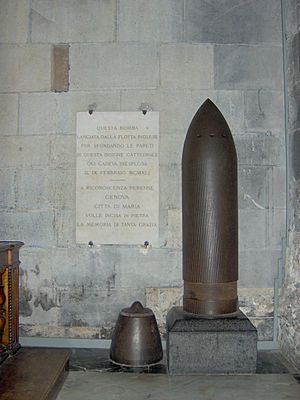Operation Grog facts for kids
Quick facts for kids Operation Grog |
|||||||
|---|---|---|---|---|---|---|---|
| Part of the Battle of the Mediterranean of World War II | |||||||
 An Armour-piercing shell from HMS Malaya that landed in Genoa Cathedral |
|||||||
|
|||||||
| Belligerents | |||||||
| Commanders and leaders | |||||||
| Strength | |||||||
|
Royal Navy Force H
|
Anti-aircraft and coastal artillery | ||||||
| Casualties and losses | |||||||
| 1 Swordfish aircraft | 5 ships sunk 18 damaged (British sources) 1 training ship sunk 2 ships damaged (Italian sources) 14 lighters sunk 144 killed and 242 wounded Severe damage to port |
||||||
Operation Grog was a secret mission carried out by the British Navy during World War II. On February 9, 1941, British warships and planes attacked the Italian cities of Genoa and La Spezia. These cities were important ports in Italy.
The main goal was to damage Italian ships and port facilities. This operation was part of the larger Battle of the Mediterranean. It showed how naval power could be used to strike at enemy targets on land.
Contents
Planning the Attack
The British forces, known as Force H, set sail from Gibraltar. This group included powerful ships like the battleship HMS Malaya, the aircraft carrier HMS Ark Royal, and the battlecruiser HMS Renown. They were also protected by several smaller, fast ships called destroyers.
The operation was first planned for late January 1941. However, it was delayed and finally began on February 6.
Tricking the Enemy
Before the main attack, some destroyers searched for enemy submarines. The larger ships then made a fake move. This was a trick to make Italian and German observers think they were protecting a convoy of supply ships. This helped keep the real target a secret.
The Bombardment of Genoa
On February 9, 1941, the British fleet reached Genoa. They began to fire their powerful guns at the harbor. This attack caused a lot of damage.
Ships and Damage
British reports stated that four cargo ships were sunk. Another 18 ships were damaged during the attack. Italian sources, however, reported less damage. They mentioned that two merchant ships, Salpi and Garibaldi, were heavily damaged. An old training ship named Garaventa was also sunk.
Many smaller boats, called lighters, were also destroyed. These boats are used to move goods around a harbor.
An Unexploded Shell
During the shelling, a large armour-piercing shell from HMS Malaya hit Genoa Cathedral. This type of shell is designed to break through thick armor. Luckily, the shell did not explode. It is still on display in the cathedral today, a reminder of the event.
The battleship Duilio, which was being repaired nearby, was not hit.
Air Attacks and Retreat
While the ships attacked Genoa, planes from the aircraft carrier HMS Ark Royal were also busy. They flew to attack the city of Livorno. These planes also dropped naval mines into the waters near La Spezia. Mines are explosives placed in water to damage ships.
The Italian fleet tried to stop the British forces. However, they were unsuccessful. All the British ships returned safely to Gibraltar by February 11.
Impact of the Operation
The attack on Genoa had a serious impact on the city. Many civilians were affected. Sadly, 144 people were killed, and 272 were wounded during the shelling. The port of Genoa also suffered severe damage.
Operation Grog was considered a success for the British. It showed their ability to strike deep into enemy territory.

